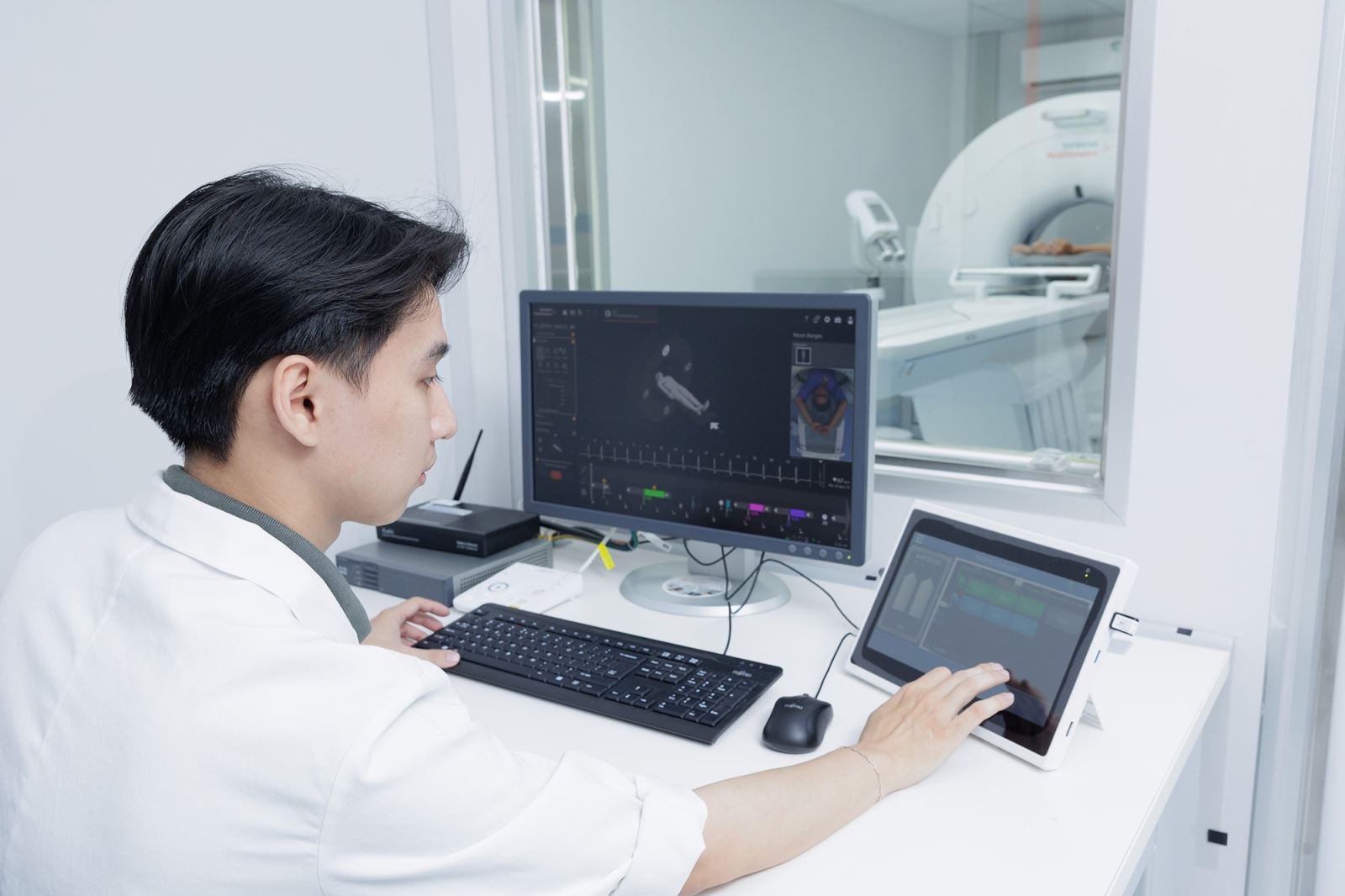Khoa Chẩn Đoán Hình Ảnh

Khoa Chẩn đoán hình ảnh bao gồm đội ngũ bác sĩ và kĩ thuật viên giàu kinh nghiệm, thực hành tốt y học thực chứng nhằm đem lại kết quả chẩn đoán và điều trị tốt nhất cho bệnh nhân. Chẩn đoán hình ảnh trong đó có Chụp CT, Chụp MRI, Chụp Nhũ Ảnh, Siêu âm, Xquang và DXA là những công cụ quan trọng và không thể thiếu trong y học hiện đại, giúp bác sĩ đưa ra những quyết định chính xác trong chẩn đoán và điều trị bệnh.
Hệ thống phòng khám CarePlus cam kết cung cấp dịch vụ thăm khám chẩn đoán hình ảnh tốt nhất với tính hiệu quả, điều kiện vệ sinh, an toàn tia xạ cũng như chất lượng của hình ảnh.
1. CHỤP CT
Chụp cắt lớp vi tính (CT) là phương pháp sử dụng tia X kết hợp với máy tính để tái tạo hình ảnh chi tiết theo từng lát cắt ngang của cơ thể. So với X-quang thông thường, chụp CT có khả năng cung cấp hình ảnh sắc nét và chi tiết hơn về mạch máu, mô mềm và xương, giúp các bác sĩ dễ dàng phát hiện bệnh lý và đánh giá tình trạng cơ thể.
Tính năng nổi bật của hệ thống chụp CT
-
Trí tuệ nhân tạo có thể tự động điều chỉnh các thông số chụp liều tia X, độ phân giải, tốc độ chụp… Dựa trên từng trường hợp bệnh nhân cụ thể để đảm bảo chất lượng hình ảnh cao nhất.
-
Chất lượng hình ảnh, độ phân giải cao và Tốc độ chụp nhanh
-
Giảm thiểu liều tia X tối đa và Nâng cao Trải nghiệm khách hàng
-
Thiết bị này còn có tính năng hỗ trợ tương tác từ xa, giúp bác sĩ hoặc kỹ thuật viên có thể giao tiếp với bệnh nhân ngay khi họ ở trong phòng chụp, tạo cảm giác an tâm hơn.
-
Máy có thể được tùy chỉnh phù hợp với nhiều nhóm bệnh nhân khác nhau, từ trẻ em, người cao tuổi cho đến các bệnh nhân cần chăm sóc đặc biệt, làm cho trải nghiệm của mọi đối tượng bệnh nhân được cải thiện đáng kể.
Đối tượng nên chụp CT?
Chụp CT thường được chỉ định cho những người có các triệu chứng hoặc tình trạng bệnh cần chẩn đoán chính xác hơn so với các phương pháp chụp ảnh khác. Những người cần chụp CT thường bao gồm:
Các trường hợp thường được chỉ định chụp CT
-
Bệnh nhân có chấn thương hoặc tai nạn, người nghi ngờ có khối u hoặc ung thư
-
Người có triệu chứng liên quan đến não, tim hoặc ở các cơ quan nội tạng khác
-
Người cần đánh giá mạch máu hoặc xương khớp
-
Người đang chuẩn bị cho phẫu thuật hoặc điều trị chuyên sâu, người cần theo dõi tình trạng bệnh sau điều trị
Tầm soát sức khỏe định kỳ, tầm soát Ung thư:
-
Tầm soát sức khỏe định kỳ
-
Tầm soát ung thư như: Phổi, Tim mạch... Hoặc đánh giá các bệnh lý mạch máu khác
2. CHỤP MRI
Chụp cộng hưởng từ là phương pháp chẩn đoán hình ảnh hiện đại, hiệu quả và phổ biến. Với đặc điểm cho hình ảnh chính xác và không gây tác dụng phụ, chụp MRI giúp khảo sát gần như mọi cơ quan bên trong cơ thể.
Ứng dụng chụp MRI trong y khoa
Chẩn đoán các bệnh lý về:
- Bệnh Thân kinh và Tim mạch
- Cột sống và Cơ xương khớp
- Các bệnh lý về Tiêu hóa và Phụ khoa
- Chẩn đoán và điều trị ung thư
- Tầm soát sức khỏe định kỳ
Tính năng nổi bật của hệ thống chụp MRI
- DotGO tự động hóa: Đảm bảo chất lượng hình ảnh nhất quán và ổn định, hỗ trợ chẩn đoán chính xác
- AI trong giảm thời gian quét: Công nghệ AI được ứng dụng để tối ưu hóa các quy trình quét, giúp giảm đáng kể thời gian chụp mà vẫn đảm bảo chất lượng hình ảnh tốt
- Giảm tiếng ồn, Cải thiện trải nghiệm bệnh nhân: Tính năng Quiet Suite giảm áp suất âm thanh lên đến 97%, mang lại trải nghiệm yên tĩnh và dễ chịu hơn cho người chụp
- Xử lý hình ảnh tiên tiến và Tối ưu hóa liều lượng tương phản
3. Chụp nhũ ảnh
Nhũ ảnh là kỹ thuật chụp X-quang cho phép phân tích cấu trúc tuyến vú để tìm ra những thay đổi bên trong vú mà khám bằng tay không thể thấy được.
Ưu điểm nổi bật:
- Là phương pháp chẩn đoán nhanh, không xâm lấn, chi phí thấp
- Tia X sử dụng trong chụp X quang tuyến vú có năng lượng thấp, nên khả năng gây hại gần như không có. Tuy nhiên chống chỉ định với phụ nữ mang thai 3 tháng đầu và những tháng sau cần cân nhắc theo lời khuyên từ bác sĩ.
- Giúp phát hiện vi vôi hóa và tổn thương bệnh lý tuyến vú khác
4. Siêu âm
Phòng khám CarePlus thực hiện các dịch vụ siêu âm tại Khoa Chẩn đoán hình ảnh trên các máy siêu âm thế hệ mới nhất, đảm bảo chất lượng hình ảnh luôn ở mức độ rõ nét nhất để phục vụ chẩn đoán.
Các dịch vụ siêu âm bao gồm:
- Siêu âm Doppler màu tuyến giáp (bao gồm hạch cổ)
- Siêu âm cổ: khảo sát tuyến mang tai, tuyến dưới hàm
- Siêu âm Doppler màu tuyến vú
- Siêu âm lồng ngực
- Siêu âm phần mềm: các tuyến mang tai, vùng nách
- Siêu âm Doppler màu tim
- Siêu âm Doppler màu mạch máu (động tĩnh mạch ngoại biên)
- Siêu âm động mạch, tĩnh mạch chi trên, chi dưới
- Siêu âm động mạch cảnh ngoài sọ
- Siêu âm màu bụng tổng quát: khảo sát gan, lách, mật, thận, tụy, bàng quang, tử cung, buồng trứng, tiền liệt tuyến
- Siêu âm bụng, cơ quan sinh dục ngoài khảo sát dị tật trẻ em
- Siêu âm động mạch thận
- Siêu âm khảo sát trào ngược thực quản ở trẻ em
- Siêu âm vùng chậu, bẹn, bìu, tinh hoàn
- Siêu âm gân, khớp và khảo sát mô mềm
- Siêm âm ống cổ tay
- Siêu âm phụ khoa
- Siêu âm thai quý I, II, III
5. Chụp X-Quang
Hệ thống Xquang kỹ thuật số (DR), thời gian chụp phim cho bệnh nhân nhanh hơn nhiều lần so với X-quang thông thường, giảm thời gian chiếu tia, bảo vệ cho các phần cơ thể quan trọng của bạn không bị nhiễm xạ, nhất là khi thực hiện các thủ thuật khó nhó phổi, xoang, sọ, cột sống, và xương thường quy, X-quang tuyến vú để phát hiện sớm ung thư vú.
6. ĐO LOÃNG XƯƠNG BẰNG PHƯƠNG PHÁP DXA
DXA (Dual-energy X-ray Absorptiometry) là phương pháp chẩn đoán hình ảnh hiện đại, thường được sử dụng để đo mật độ xương và đánh giá nguy cơ loãng xương, đặc biệt trong các khu vực như hông và cột sống. Kỹ thuật này nổi bật nhờ tính chính xác cao, thời gian thực hiện ngắn, và liều tia X rất thấp, an toàn cho người bệnh. DXA rất phù hợp cho các đối tượng có nguy cơ cao về loãng xương như phụ nữ sau mãn kinh, người cao tuổi, những người bị thiếu canxi kéo dài, hoặc có tiền sử gia đình mắc bệnh loãng xương. Quy trình này hỗ trợ chẩn đoán sớm và điều trị hiệu quả.
BS. CK2. Cao Thiên Tượng
Chuyên khoa: Khoa Chẩn Đoán Hình Ảnh
Phòng khám: Phòng khám Quận 1
Kinh nghiệm: Cố vấn chuyên môn - Chuyên khoa Chẩn đoán hình ảnh
BS. CK1. Nguyễn Bá Huy
Chuyên khoa: Khoa Chẩn Đoán Hình Ảnh
Phòng khám: Phòng khám Quận 1
Kinh nghiệm: BS có nhiều năm kinh nghiệm trong lĩnh vực Chẩn đoán hình ảnh, có thời gian công tác trong các Bệnh viện hạng I Tp.HCM và Phòng khám hàng đầu như: Bệnh viện Nguyễn Tri Phương, Phòng khám Bệnh viện Đại Học Y Dược 1… BS đã tham gia các lớp đào tạo nâng cao chuyên môn của chuyên ngành Chẩn đoán hình ảnh được tổ chức trong nước. Show more
BS. CK1. Phùng Thị Lan Thanh
Chức danh: Trưởng Khoa Chẩn Đoán Hình Ảnh
Chuyên khoa: Khoa Chẩn Đoán Hình Ảnh
Phòng khám: Phòng khám Quận 1
Kinh nghiệm: Hơn 23 năm kinh nghiệm công tác tại Bệnh viện Nguyễn Tri Phương
THS. BS. Nguyễn Thị Vũ Linh
Chuyên khoa: Khoa Chẩn Đoán Hình Ảnh
Phòng khám: Phòng khám Tân Bình, Phòng khám Quận 7
Kinh nghiệm: Thạc sỹ Chẩn đoán hình ảnh. 9 năm kinh nghiệm làm việc tại Bệnh viện Ung bướu Đà Nẵng, Bệnh viện Xuyên Á. Chuyên chẩn đoán hình ảnh các bệnh lý Ung bướu. Chứng chỉ siêu âm tim Trường ĐH Y Phạm Ngọc Thạch, Chứng chỉ siêu âm sản phụ khoa Bệnh viện Từ Dũ. Show more
BS.CK1. ĐOÀN THỊ MINH HỒNG
Chuyên khoa: Khoa Chẩn Đoán Hình Ảnh
Phòng khám: Phòng khám Quận 1
Kinh nghiệm: Hơn 20 năm làm việc trong lĩnh vực siêu âm. Từng công tác tại Bệnh viện Ung bướu, Bệnh viện Chợ Rẫy


